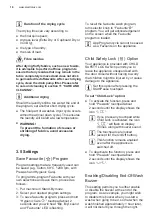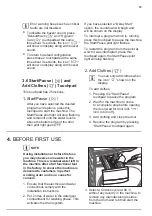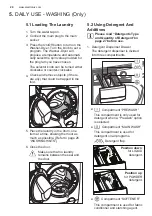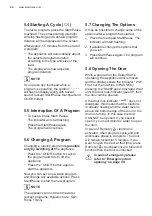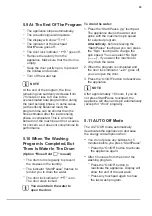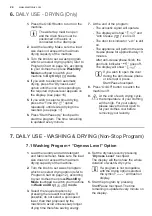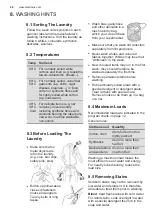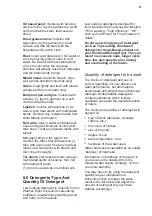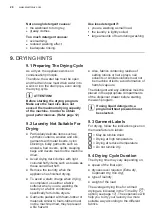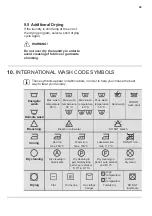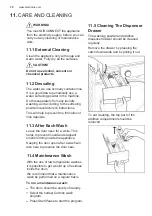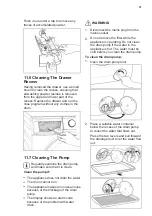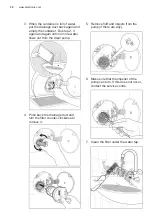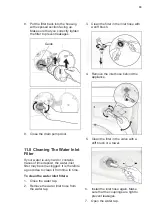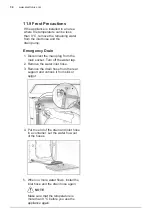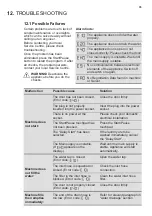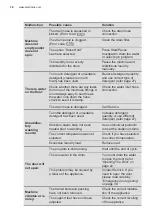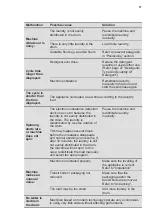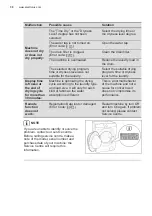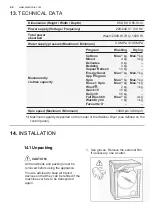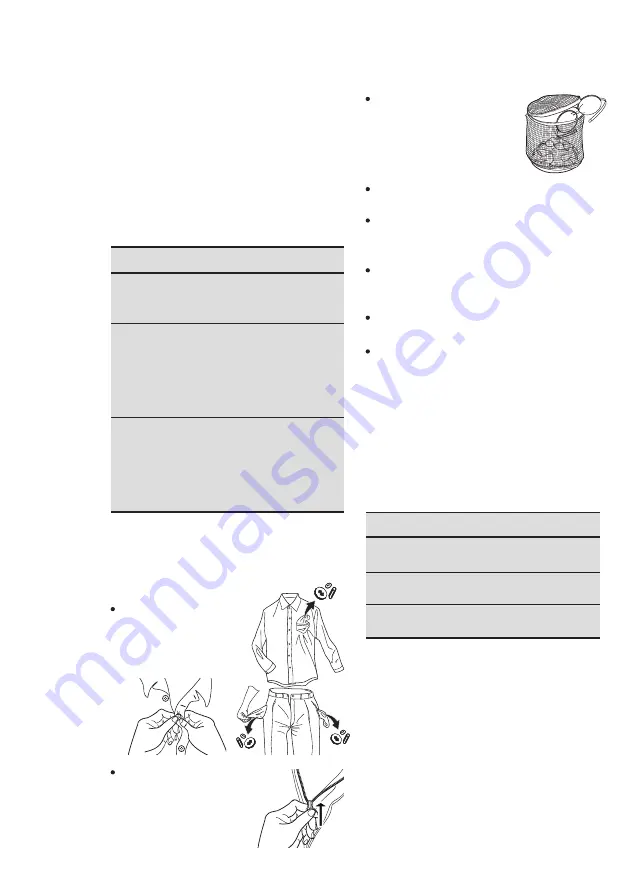
26
www.electrolux.com
26 www.electrolux.co.th
WASHING HINTS
8.
Follow the wash code symbols on each
garment label and the manufacturer’s
washing instructions. Sort the laundry as
follows: whites, coloureds, synthetics,
delicates, woollens.
8.1 Sorting The Laundry
8.2 Temperatures
90°C
Temp Soil level
60°C
50°C
40°C
30°C
Cold
For normally soiled, colourfast
garments (e.g. shirts, night
dresses, pajamas....) in linen,
cotton or synthetic fibres and
for lightly soiled white cotton
(e.g.underwear).
For delicate items (e.g. net
curtains), mixed laundry
including synthetic fibres and
woollens bearing the label pure
new wool, machine washable,
non-shrink.
For normally soiled white
cottons and linen (e.g. teacloths,
towels, tablecloths, sheets...).
Never wash whites and coloured
fabrics together. Whites may lose their
“whiteness” in the wash.
New coloured items may run in the first
wash; they should therefore be
washed separately the first time.
Button up pillowcases,
close zip fasteners,
hooks and poppers.
Tie any belts or long
tapes.
Remove persistent stains before
washing.
Rub particularly soiled areas with a
special detergent or detergent paste.
Treat curtains with special care.
Remove hooks or tie them up in a bag
or a net.
Make sure that no
metal objects are
left in the laundry
(e.g. coin, hair clips,
safety pins, pins).
8.3 Before Loading The
Laundry
Recommended loads are indicated in the
program charts on page 12.
Washing a maximum load makes the
most efficient use of water and energy.
For heavily soiled laundry, reduce the
load size.
Cotton, linen
drum full but not too
tightly packed;
Clothes Load Quantity
Synthetics
drum no more than
half full;
Delicate fabrics
and woollens
drum no more than
one third full.
8.4 Maximum Loads
Blood
: treat fresh stains with cold water.
For dried stains, soak overnight in water
with a special detergent then rub in the
soap and water.
Stubborn stains may not be removed by
just water and detergent. It is therefore
advisable to treat them prior to washing.
8.5 Removing Stains
Wash bras, pantyhose
and other delicates in a
mesh laundry bag,
which you can purchase
from your supermarket.
Make sure that you wash lint collectors
separately from lint producers.
General rules:
ENGLISH 27
Oil based paint
: moisten with benzine
stain remover, lay the garment on a soft
cloth and dab the stain; treat several
times.
Dried grease stains
: moisten with
turpentine, lay the garment on a soft
surface and dab the stain with the
fingertips and a cotton cloth.
Rust
: oxalic acid dissolved in hot water or
a rust removing product used in cold
water. Be careful with rust stains which
are not recent since the cellulose
structure will already have been damaged
and the fabric tends to hole.
Mould stains
: treat with bleach, rinse
well (whites and fast coloureds only).
Grass
: soap lightly and treat with bleach
(whites and fast coloureds only).
Ball point pen and glue
: moisten with
acetone (*), lay the garment on a soft
cloth and dab the stain.
Lipstick
: moisten with acetone (*) as
above, then treat stains with methylated
spirits. Remove any residual marks from
white fabrics with bleach.
Red wine
: soak in water and detergent,
rinse and treat with acetic or citric acid,
then rinse. Treat any residual marks with
bleach.
Ink
: depending on the type of ink,
moisten the fabric first with acetone (*),
then with acetic acid; treat any residual
marks on white fabrics with bleach and
then rinse thoroughly.
Tar stains
: first treat with stain remover,
methylated spirits or benzine, then rub
with detergent paste.
(*) do not use acetone on artificial silk.
Low sudsing detergent is required for this
Washer-Dryer to prevent oversudsing
problems, unsatisfactory washing result
and harm to the machine.
8.6 Detergents Type And
Quantity Of Detergent
Do not use wrong types of detergent,
such as Top Loading, Handwash
detergent or Soap-Based products in
your frontload Washer-Dryer. This can
result in excessive suds, longer cycle
time, low spin speeds, poor rinsing
and overloading of the motor.
The choice and quantity of detergent will
depend on ;
type of fabric (delicates, woollens,
cottons, etc.) ;
degree of soil ;
size of the load ;
wash temperature ; and
hardness of the water used.
the colour of clothes ;
Information on hardness of the water in
your area can be obtained from the
relevant water supply company, or from
your local authority.
You may have to try using the detergent
quantity as per manufacturers’
instructions then compare the wash
result to the list below and adjust the
amount of detergent for your future
washes accordingly.
Water hardness is classified by so-called
“degrees” of hardness.
The choice of detergent and use of
correct quantities not only affects your
wash performance, but also helps to
avoid waste and protect the environment.
Although biodegradable detergents
contain substances which in large
quantities can upset the delicate balance
of nature.
Low sudsing detergents designed for
front load washing machines are labelled
“Front Loading”, “high efficiency”, “HE”,
such as Cold Power for Front Loaders or
“Matic”.
Quantity of detergent to be used
Summary of Contents for EWW1042R7WB
Page 1: ...Washer Dryer EWW1042R7WB User Manual 2 WI FI Connectivity Setup 46 ...
Page 48: ...48 www electrolux com NOTE ...
Page 49: ...49 NOTE ...
Page 50: ...50 www electrolux com NOTE ...
Page 51: ...51 ...







